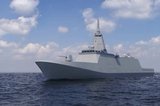Learning from Japan: how to transform a fleet at speed
An artist’s impression of the Japanese ASEV destroyer. (Image: Japan MoD)
The Japanese Maritime Self-Defense Force (JMSDF) has had to adapt rapidly in recent years to deal with a rising threat profile in the Indo-Pacific region.
It is not alone in having to respond fast to changing threats and emerging aggressors. The US Navy (USN) for one is currently extending the lifespans of some of its oldest destroyers, while gearing up for a potential future conflict with China – the only superpower in the world with a navy that exceeds the size of its own.
But a speaker at the recent Surface Warships conference in London explained the way the
Already have an account? Log in
Want to keep reading this article?
More from Naval Warfare
-
![Mitsubishi eyes future with Australia’s Mogami selection]()
Mitsubishi eyes future with Australia’s Mogami selection
With Australia’s selection of the Mogami-class for Project Sea 3000, Mitsubishi is investigating local production in the next decade as potential export opportunities emerge.
-
![Thales’ new Sonar 76Nano could equip UK Royal Navy on anti-submarine warfare missions]()
Thales’ new Sonar 76Nano could equip UK Royal Navy on anti-submarine warfare missions
The new sonar is designed to equip uncrewed underwater vessels, with the potential to be used by the Royal Navy for its Atlantic Bastion and Atlantic Net missions.
-
![Hanwha wins Australian government approval to increase its stake in Austal]()
Hanwha wins Australian government approval to increase its stake in Austal
The contract would mean the two shipbuilders can collaborate strategically and enhance shipbuilding capabilities in Western Australia.






















